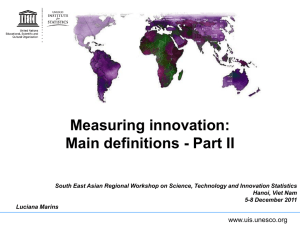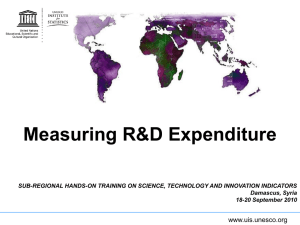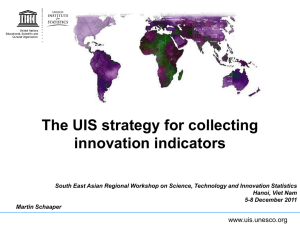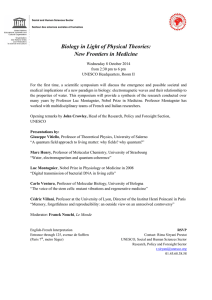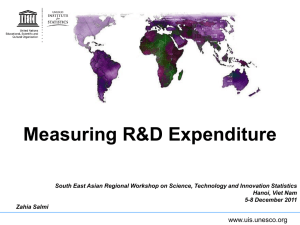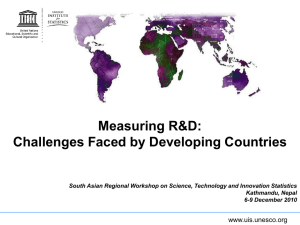Measuring Research and Experimental Development
advertisement
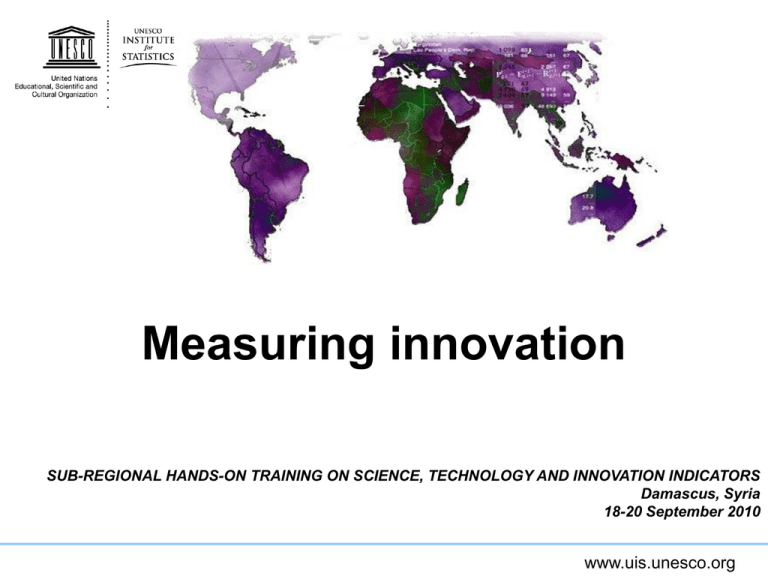
Measuring innovation SUB-REGIONAL HANDS-ON TRAINING ON SCIENCE, TECHNOLOGY AND INNOVATION INDICATORS Damascus, Syria 18-20 September 2010 www.uis.unesco.org Measuring Innovation Oslo Manual – 2005 (Guidelines for collecting and interpreting innovation data) UIS - Annex to the Oslo Manual on Measuring Innovation in Developing countries www.uis.unesco.org Why measure innovation? Innovation – key to the growth of output and productivity. The relationship between innovation and economic development is widely acknowledged. Innovation policy should be evidence-based. Innovation data • to better understand innovation and its relation to economic growth; • to provide indicators for benchmarking national performance. www.uis.unesco.org The innovation measurement framework www.uis.unesco.org Innovation: definition (Oslo Manual 2005) The implementation of: Technological innovation New or significantly improved product (good or service); or New process; or Non-technological innovation New marketing method; or New organisational method. www.uis.unesco.org Types of innovations Product innovation Process innovation Marketing innovation Organisational innovation www.uis.unesco.org Diffusion and degree of novelty Diffusion • How innovations spread • Without diffusion no economic impact New to the firm New to the market New to the world Disruptive innovations • innovation with significant impact on a market • focuses on the impact of innovations as opposed to their novelty • May become apparent only long after the innovation has been introduced. www.uis.unesco.org Innovation activities Innovation activities All scientific, technological, organisational, financial and commercial steps which actually, or are intended to, lead to the implementation of innovations. Some innovation activities are themselves innovative, others are not novel activities but are necessary for the implementation of innovations. Innovation activities also include R&D that is not directly related to the development of a specific innovation. www.uis.unesco.org Innovation activities for product and process innovations Intramural (in-house) R&D Acquisition of R&D (extramural R&D) Acquisition of other external knowledge Acquisition of machinery, equipment and other capital goods Other preparations for product and process innovations Market preparations for product innovations Training www.uis.unesco.org Innovation activities for marketing and organisational innovations Preparations for marketing innovations: activities related to the development and implementation of new marketing methods. • Includes acquisitions of other external knowledge and other capital goods that are specifically related to marketing innovations. Preparations for organisational innovations: activities undertaken for the planning and implementation of new organisation methods. • Includes acquisitions of other external knowledge and other capital goods that are specifically related to organisational innovations. www.uis.unesco.org Kinds of innovation activities Successful in having resulted in the implementation of a new innovation (though they need not have been commercially successful). Ongoing, work in progress, which has not yet resulted in the implementation of an innovation. Abandoned before the implementation of an innovation. www.uis.unesco.org Classifying firms by degree of innovativeness Innovative firm • The innovations need not have been a commercial success – many innovations fail Innovation active firm • Regardless of whether the activity resulted in the implementation of an innovation Potentially innovative firm • Innovation efforts but no achieved results. • Key element for innovation policy • Annex for developing countries. www.uis.unesco.org Factors influencing innovation Objectives • Identifying enterprises’ motives for innovating and measuring their importance. Hampering factors • Reasons for not starting innovation activities at all, or factors that slow innovation activity or have a negative effect on expected results. www.uis.unesco.org Objectives and effects of innovation Competition, demand and markets • • • • • • • Replace products being phased out Increase range of goods and services Develop environment-friendly products Increase or maintain market share Enter new markets Increase visibility or exposure for products Reduced time to respond to customer needs Production and delivery • • • • • • • Improve quality of goods and services Improve flexibility of production or service provision Increase capacity of production or service provision Reduce unit labour costs Reduce consumption of materials and energy Reduce product design costs Achieve industry technical standards • • • • Reduce production lead times Reduce operating costs for service provision Increase efficiency or speed of supplying and/or delivering goods or services Improve IT capabilities Workplace organisation • • • • • Improve communication and interaction among different business activities Increase sharing or transferring of knowledge with other organisations Increase the ability to adapt to different client demands Develop stronger relationships with customers Improve working conditions Other • • Reduce environmental impacts or improve health and safety Meet regulatory requirements www.uis.unesco.org Factors hampering innovation activities Knowledge factors: • • • • • • • Innovation potential (R&D, design, etc.) insufficient Lack of qualified personnel: Within the enterprise / In the labour market Lack of information on technology / markets Deficiencies in the availability of external services Difficulty in finding co-operation partners for: Product or process development / Marketing partnerships Organisational rigidities within the enterprise: Attitude of personnel/ managers towards change, Managerial structure of enterprise Inability to devote staff to innovation activity due to production requirements Institutional factors: • • • Lack of infrastructure Weakness of property rights Legislation, regulations, standards, taxation Cost factors: • • • • Excessive perceived risks Cost too high Lack of funds within the enterprise Lack of finance from sources outside the enterprise: Venture capital / Public sources of funding Market factors: • • Uncertain demand for innovative goods or services Potential market dominated by established enterprises Other reasons for not innovating: • • No need to innovate due to earlier innovations No need because of lack of demand for innovations www.uis.unesco.org Impacts and outcomes Impacts of innovations • effects on sales and market share • changes in productivity and efficiency • changes in international competitiveness and in total factor productivity, • knowledge spillovers • increase in the amount of knowledge flowing through networks. Outcomes of product innovations • % of sales derived from new or improved products. www.uis.unesco.org Linkages are crucial Linkages between the firm and government laboratories, universities, policy departments, regulators, competitors, suppliers, and customers. Links to sources of information, knowledge, technologies, practices, and human and financial resources. Types of external linkages: • Open information sources • Acquisition of knowledge and technology. • Innovation co-operation www.uis.unesco.org Sources for transfers of knowledge and technology Internal sources within the enterprise: R&D Production Marketing Distribution Other enterprises within the enterprise group Open information sources Sources for purchases of knowledge & technology Cooperation partners * * * * * * * * * * * * * * * * * * * * * * * * * * * * * * * * * * * * External market and commercial sources: Competitors Other enterprises in the industry Clients or customers Consultants/consultancy firms Suppliers Commercial laboratories Public sector sources: Universities and other higher education institutions Government/public research institutes Private non profit research institutes Specialised public innovation support svcs General information sources: Patent disclosures / Professional conferences, meetings, literature and journals / Fairs and exhibitions / Professional associations, trade unions / Other local associations / Informal contacts or networks / Standards or standardisation agencies / Public regulations (i.e. * www.uis.unesco.org Data collection: survey approach The “subject” based approach • innovative behaviour and activities of the firm as a whole The “object” approach • collection of data about specific innovations The subject approach is the one chosen for innovation surveys. www.uis.unesco.org Combining innovation & R&D surveys Pro • Reduce overall response burden • Analysing relation between R&D and innovation at the unit level • Increases the frequency of innovation surveys Against • Length of questionnaire • Confusion between the concepts of R&D and innovation • Different survey frames Possibility of merging with other business surveys (e.g. ICT, knowledge management practices) www.uis.unesco.org Expenditures Current innovation expenditures • labour costs • other current costs Capital expenditures • land and buildings • instruments and equipment • computer software www.uis.unesco.org Classification by main economic activity Data broken down by Principal economic activity of the statistical unit (“industry”), according to the International Standard Industrial Classification (ISIC Rev. 3.1) www.uis.unesco.org Classification by size Number of employees Detailed 10-49 0 50-249 1-9 250 and above 10 - 49 50 - 99 100 - 249 250 - 499 500 - 999 1 000 - 4 999 5 000 and above. www.uis.unesco.org Classification by type of institution Private enterprise: • National (no Controlled Affiliates (CA) abroad) • Multinational Public enterprise: • Resident non-financial corporations and quasicorporations that are subject to control by government units. www.uis.unesco.org Annex to the Oslo Manual Developing countries conduct innovation surveys as well. Following Oslo Manual standards, but with adaptations for capturing the particular characteristics of innovation processes. Latin American adaptations captured in the Bogotá Manual, published by RICYT. www.uis.unesco.org Annex to OM (continued) Annex to Oslo Manual 3rd edition: Innovation surveys in developing countries. UIS circulated a base document prepared by RICYT to a vast network of experts in the developing world covering China, Thailand, Singapore, Malaysia, Hungary, India, Lebanon, South Africa, and Tanzania. UIS drafted the final annex based on this input. www.uis.unesco.org Characteristics of innovation in developing countries Size and structure of markets and firms Instability Informality Particular economic and innovation environments Reduced innovation decision-making powers Weak innovation systems Characteristics of innovation www.uis.unesco.org Innovation measurement in developing countries Definitions unchanged But incorporating the concept of potentially innovative firm Measurement priorities: • Innovation capabilities » Human resources » Linkages » Quality assurance systems » ICTs • Expenditure on innovation activities • Organizational innovation www.uis.unesco.org Principal adaptations ICTs in innovation surveys • strategic use of new technologies (Front office vs Back office) Linkages • matrix of ‘linkage agents’ and ‘types of linkage’ • geographical location of linkages; local, regional, national Innovation Activities • Hardware purchase, and Software purchase • Industrial design, and Engineering activities • Lease or rental of machinery, equipment and other capital goods • In-house software system development • Reverse engineering Human resources (by qualification, occupation, gender) and training Quality and environmental management www.uis.unesco.org Methodological issues for developing country contexts Weakness of statistical systems Running the survey Questionnaire design Frequency Publication Difficulties • lack of appreciation of the importance of innovation • managers are secretive about finance • lack of adequate legislative base www.uis.unesco.org Thinking ahead The role of entrepreneurs and their attitudes towards innovation. The intention to capture innovations driven by factors other than market forces, in particular public sector innovations. Innovation in the primary sector (particularly in agriculture). Better measuring minor or incremental changes, including innovative applications of existing products or processes, and the so-called 'backwards integration' of technological capability. The development of indicators reflecting sub-national (regional) innovation systems. www.uis.unesco.org Issues arising in the follow-up to the Annex Innovation in informal sector? Innovation from traditional knowledge? Surveying innovation, rather than R&D, in business (and informal) sector? www.uis.unesco.org Thank you! http://www.uis.unesco.org m.schaaper@uis.unesco.org www.uis.unesco.org
